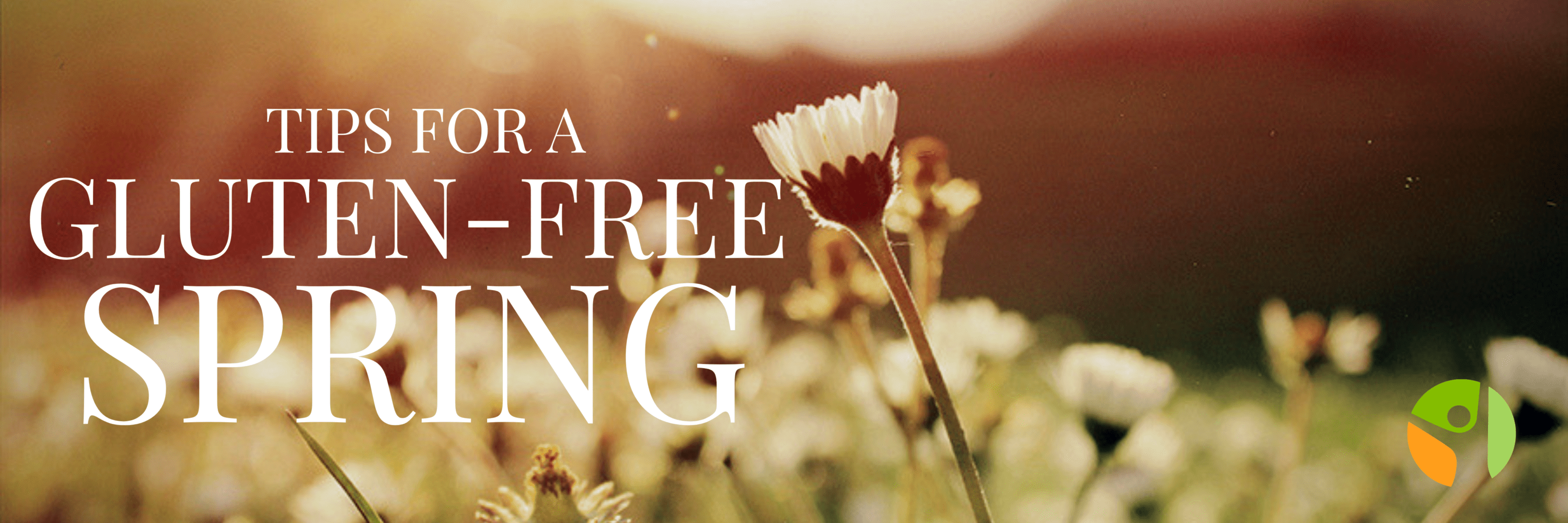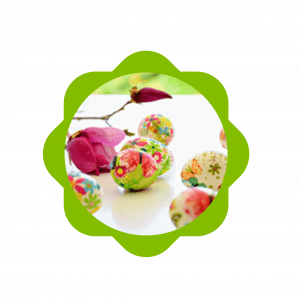
Spring is an exciting time of year for many of us. It means increased temperatures and the return of flowers and life outside. Springtime holds a number of holidays such as Easter, Passover, St Patrick’s Day, Mothers Day and Cinco De Mayo (and of course, Celiac Awareness Month is May!).
We’ve compiled a list of safe, gluten-free food and candy ideas to get you through some of these spring festivities. Enjoy!
 Each year we receive questions about Easter candy. There are so many kinds and brands of candy in stores it can be hard to determine what is gluten-free and what is not.
Each year we receive questions about Easter candy. There are so many kinds and brands of candy in stores it can be hard to determine what is gluten-free and what is not.
Let’s start with candy that is safe for celiac disease and gluten-sensitivity disorders. Dove chocolate products are mostly gluten-free, so what about that giant Dove chocolate bunny that you’ve been eying up at the store? It’s gluten-free! The manufacturer of all of Dove’s products claims it will list ingredients containing gluten on the labels. However most of their products are already gluten-free.
Thinking about putting some Jelly Belly Jelly Beans in that Easter basket? Go for it. They’re safe. What about Easter Peeps? Always check the label but Peeps are generally gluten-free. One popular candy that we want to warn you about is the Cadbury Cream Eggs. As popular and tasty as they are, we do not recommend them. The Hershey’s website regularly updates their list of gluten-free products and Cadbury Eggs are not on it. Although they do not list any ingredients containing gluten, they may be susceptible to cross-contact. Your best bet would be to steer clear altogether.
Learn more about gluten-free candy.
It can be hard to participate in these springtime family celebratory meals as someone who has to maintain a strict gluten-free diet. Many times family and friends don’t understand what means and offer up all kinds of delicious food not realizing it contains gluten. Other times they may offer gluten-free alternatives but not take into consideration the cross contamination that occurs in the kitchen.
 To save you some time, we’ve put together a list of gluten-free recipes that you and your family can safely enjoy for spring holidays:
To save you some time, we’ve put together a list of gluten-free recipes that you and your family can safely enjoy for spring holidays:
As well as a guide for entertaining gluten-free guests:
Entertaining Gluten-Free Guests
Facts and Tips for a Gluten-Free Passover
The following facts and tips about Passover are from Annsley Klehr, the owner of Gluten Freedoms, LLC, a gluten-free coaching and consulting business.
Fact #1: Some Jews also avoid rice, corn, peanuts, legumes, and pulses, since they could be grown in the same fields as the wheat and have a risk for cross-contamination. (This rule really depends on the person and how closely he/she follows Jewish Law).
Tip #1: Choose how strictly you want to keep a Passover diet. Passover is a time for celebration and remembrance, but you also never want to compromise your health. I choose to eat rice, corn, peanuts, and legumes on Passover.
Fact #2: There is another group of strictly Orthodox Jews who do not eat “gebrochts,” which is Yiddish for “broken.” That means that they avoid any matzah (wheat) product that has come into contact with liquid after it has been baked.
Tip #2: Since gebrochts technically refers to wheat-based products, then “non-gebrochts” means products that do not contain wheat. Look for this statement on packaged goods and you will know that they are not only wheat-free, but also produced in a wheat-free facility, due to the strict nature of Passover laws.
Fact #3: According to KosherConsumer.org, for a product to be qualified as “kosher for Passover” it must be free of “Wheat – all classes, Barley, Spelt, Rye, Oats, Legumes & rice or any derivative of theirs.” (Matzah is an exception because it is unleavened.) In addition, there is a strict sterilization process for any equipment used to manufacture “kosher for Passover” products.
Tip #3: The kosher for Passover facilities are extremely careful with grains, so I often stock up on gluten-free products for the rest of the year:
Note: Not all products follow the strict Orthodox traditions. Therefore, some products for Passover are made in facilities that also process wheat. Read labels carefully.
 Each year we receive questions wondering if Easter egg dye is considered gluten-free. The good news is, most brands like PAAS easter egg dye kits are gluten-free but always check the labeling. Pure distilled vinegar (often used in egg dyeing) is also gluten-free.
Each year we receive questions wondering if Easter egg dye is considered gluten-free. The good news is, most brands like PAAS easter egg dye kits are gluten-free but always check the labeling. Pure distilled vinegar (often used in egg dyeing) is also gluten-free.
You can mix distilled vinegar and gluten-free food coloring to create your own egg-dyes.
Cinco de Mayo is an annual Mexican holiday held on May 5 that’s grown into a global celebration, often centered around food and drinks.
You’re at a Cinco De Mayo party and there are lots of great Mexican foods spread across the table. What can you eat? Avoid flour-based tortillas, watch out for fried foods, including some corn chips and always make sure you know how the food was prepared. That being said, many traditional Cinco de Mayo foods are naturally gluten-free. Corn tortillas and corn chips are safe to consume as long as they haven’t been fried in a fryer that is shared with food containing gluten. There are many options when it comes to corn-based foods such as tacos, enchiladas, nachos and more.
Don’t be afraid to enjoy that margarita either! Pure distilled tequila is gluten-free. Just be sure to look into any potential added ingredients or flavorings as sometimes they may contain gluten.
Gluten-Free Margarita Recipe
 Mix together the following ingredients in a shaker and then strain into a sugar or salt-rimmed glass:
Mix together the following ingredients in a shaker and then strain into a sugar or salt-rimmed glass:
Garnish with a lime slice or twist and enjoy!
 St. Patrick’s Day is another springtime holiday that’s celebrated across the globe. It’s not only an Irish cultural and religious day of celebration, it’s frequently a day for good eating, drinking and spending quality time with friends and family. Many opt to make home-cooked traditional Irish meals like corned beef and cabbage, Irish soda bread, shepherds pie, and of course beer! Often times restaurants will have specials surrounding these festivities as well. Many of these meals can be made gluten-free.
St. Patrick’s Day is another springtime holiday that’s celebrated across the globe. It’s not only an Irish cultural and religious day of celebration, it’s frequently a day for good eating, drinking and spending quality time with friends and family. Many opt to make home-cooked traditional Irish meals like corned beef and cabbage, Irish soda bread, shepherds pie, and of course beer! Often times restaurants will have specials surrounding these festivities as well. Many of these meals can be made gluten-free.
You can find a list of our own gluten-free St. Patrick’s Day Recipes here:
And here’s a gluten-free recipe for a local favorite St. Patrick’s Day treat:
Gluten-Free Irish Potato Candy Recipe
Ingredients
Directions
Prepare a baking pan by lining it with parchment paper. In a mixture combine cream cheese, butter, powdered sugar, vanilla and coconut until combined. Roll into balls or oval shape to resemble a potato and place on parchment paper lined baking pan. Place in the refrigerator for about 1 hour.
 Now let’s talk about beer! As someone living with celiac disease or a gluten-related disorder, beer is often off the menu. However, there are a number of beers currently on the market that are made without gluten. One example is Redbridge, which is made from sorghum instead of barley or wheat. Produced by Anheuser-Busch, Redbridge was the first nationally available sorghum beer and is safe for those with celiac disease and wheat allergies. If unsure about a particular beer, you may want to skip it and enjoy other forms of alcohol instead. Hard ciders, alcoholic beverages made from fermented fruit juices and pure distilled liquors are gluten-free.
Now let’s talk about beer! As someone living with celiac disease or a gluten-related disorder, beer is often off the menu. However, there are a number of beers currently on the market that are made without gluten. One example is Redbridge, which is made from sorghum instead of barley or wheat. Produced by Anheuser-Busch, Redbridge was the first nationally available sorghum beer and is safe for those with celiac disease and wheat allergies. If unsure about a particular beer, you may want to skip it and enjoy other forms of alcohol instead. Hard ciders, alcoholic beverages made from fermented fruit juices and pure distilled liquors are gluten-free.
Learn more about gluten and beer here:
Is Beer Gluten-Free?
And more about distilled liquor here:
Is Liquor Gluten-Free?
Opt-in to stay up-to-date on the latest news.
Yes, I want to advance research No, I'd prefer not to